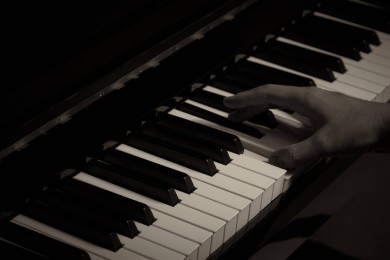Piano packs consist of high-quality recorded piano sounds, loops, and MIDI files that seamlessly integrate into various music production software.
To create a compelling piano sample pack, it is imperative to pay attention to detail, possess musical expertise, and deeply understand the needs and preferences of the target audience.
In this comprehensive guide, we will delve into the essential steps involved in creating piano sample packs. From recording techniques to sound selection, post-processing, and packaging, we will explore each aspect in detail.
VSTs or Recording Live When Creating a Sample Packs?
When creating a sample pack it’s important to know what type of pack you’re going to create: Melody Pack, Sample Pack, or a mixture of both.
Melody Pack
When creating a melody pack using either a VST or real piano will do. Of course having access to a real piano is ideal, but not always practical.
Furthermore, a real piano will require the producer to know how to play the piano instead of using MIDI support to assist their playing.
When I creating my Sad Piano melody pack I used VSTs as there are many high quality piano sounds available!
Sample Pack
Use a real piano or synthesizers (like Serum) when creating a piano sample pack focused on providing one shots.
Both of these approaches will give the buyer a unique and new sound that they use and can only buy from you!
Additionally, when making these custom one shots it’s a great idea to create a bundle melody loops to include in the pack to add value and show what the pack is capable of!
Creating the Sample Pack
Now that you know what type of pack you’re going to make here are some key steps that will help you create your music pack:
- Recording Techniques: Recording a live Piano requires micing techniques and knowledge on how to record an instrument in a room.
- Sound Selection: Whether it is a VST or live Piano, knowing how to use the sounds are important to creating a pleasant sounding melody!
- Post-processing: Once the sounds are recorded or the melody loops completed its time to further enhance your audio!
- Packaging: Knowing how to make digital art to promote and advertise your new pack is vital!
Below I will go into each one of these steps in more detail.
Recording Techniques
To create a captivating piano sample pack, it is crucial to have access to a high-quality acoustic piano instrument.
While digital pianos can produce satisfactory results, an acoustic piano offers a more authentic and organic sound that resonates with listeners. Here are some recording techniques to consider:
- Room Selection: Choose a room with exceptional acoustics to capture the rich and resonant sounds of the piano. Avoid rooms with excessive echo or background noise, as they can negatively impact the overall quality of the samples.
- Microphone Placement: Experiment with different microphone placements to capture various perspectives of the piano. Close miking techniques, such as placing the microphones near the hammers, can yield detailed and percussive sounds. On the other hand, room miking techniques capture the piano’s natural ambience and create a more spacious sound.
- Multiple Takes: Recording multiple takes of each piano sample is crucial to provide users with a variety of articulations and playing styles. This adds versatility and realism to the sample pack, allowing users to create expressive compositions.
Furthermore, it is essential to consider the quality of the recording equipment, such as high-end microphones and preamps, to capture the nuances of the piano accurately.
Sound Selection
Once you have recorded a wide range of piano samples, it’s time to curate and select the best ones for your sample pack. Consider the following factors to ensure a diverse and appealing collection:
- Variety of Pianos: Include samples from different types of pianos, such as grand pianos, upright pianos, and electric pianos. Each piano type possesses a unique tonal quality and character that can cater to different musical genres. This ensures that your sample pack can accommodate a wide range of musical styles.
- Dynamic Range: Ensure that your sample pack covers a wide dynamic range, including soft, medium, and loud samples. This allows users to create expressive and dynamic compositions that showcase the full potential of the piano.
- Articulations: Include various articulations such as staccato, legato, sustain, and tremolo to provide users with different playing techniques and expressive possibilities. These articulations add depth and realism to the sample pack, enabling users to create lifelike piano performances.
Additionally, consider including samples with different tonal characteristics, such as bright and warm tones, to cater to the diverse preferences of your audience.

Post-processing
To enhance the quality and usability of your piano samples, it is essential to apply post-processing techniques. Here are some considerations:
- EQ and Compression: Utilize equalization and compression to balance the tonal qualities and dynamics of the piano samples. This helps create a polished and consistent sound across the entire sample pack. Carefully sculpt the frequency response to highlight the natural characteristics of each piano sample.
- Reverb and Delay: Apply appropriate reverb and delay effects to add depth and space to the piano samples. This helps create a more immersive and realistic experience for the users, making them feel as if they are listening to a live performance. Experiment with different reverbs and delays to find the perfect combination for each piano sample.
- Noise Reduction: Remove any unwanted noise or artifacts from the samples using noise reduction techniques. This ensures a clean and professional sound, allowing users to focus on the beauty and nuances of the piano without distractions. Be cautious not to overdo the noise reduction process, as it can negatively affect the natural character of the samples.
Moreover, consider experimenting with other post-processing techniques, such as modulation effects or saturation, to add unique flavors to your piano samples and make them stand out from the crowd.
Packaging
Packaging plays a crucial role in presenting your piano sample pack to potential users. Consider the following elements:
- Naming and Organization: Clearly label and organize the samples in a logical manner. Use descriptive names that reflect the character and qualities of each sample. This makes it easier for users to navigate through the sample pack and find the specific sounds they need.
- Metadata and Tagging: Add relevant metadata and tags to the samples, including key, tempo, and genre. This enables users to easily search for specific sounds within the sample pack, saving them valuable time and effort. Proper tagging ensures that your sample pack is user-friendly and accessible.
- Demo Tracks: Include demo tracks or compositions that showcase the potential of the piano samples. This helps users understand how the samples can be used in their own productions and sparks their creativity. A well-crafted demo track can inspire users to explore different musical ideas and experiment with your piano samples.
Consider creating different versions of the demo tracks, showcasing various musical genres and styles, to showcase the versatility of your piano sample pack.
Conclusion
Creating piano sample packs is a meticulous process that requires a combination of technical expertise, musicality, and attention to detail.
By following the steps outlined in this guide, you can create a compelling and versatile collection of piano samples that resonates with your target audience.
Remember to invest time in recording techniques, sound selection, post-processing, and packaging to ensure a high-quality product that inspires creativity and musical expression.
FAQ
Q: Why is it important to record piano samples in a room with exceptional acoustics?
A: Recording piano samples in a room with exceptional acoustics helps capture the rich and resonant sounds of the piano, enhancing the overall quality of the samples.
Q: Why is it necessary to record multiple takes of each piano sample?
A: Recording multiple takes of each piano sample provides users with a variety of articulations and playing styles, adding versatility and realism to the sample pack.
Q: Why should a piano sample pack include samples from different types of pianos?
A: Including samples from different types of pianos, such as grand pianos, upright pianos, and electric pianos, ensures that the sample pack can accommodate a wide range of musical styles and genres.
Q: Why is it important to add metadata and tags to piano samples?
A: Adding metadata and tags, such as key, tempo, and genre, to piano samples enables users to easily search for specific sounds within the sample pack, saving them time and effort.


